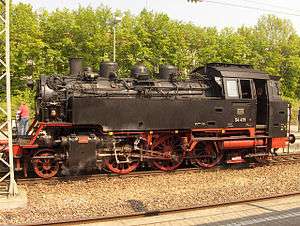DRG Class 64
| DRG Class 64 | |
|---|---|
 | |
| Number(s) | DRG 64 001–520 |
| Quantity | 520 |
| Year(s) of manufacture | 1928–1940 |
| Retired | 1975 |
| Wheel arrangement | 2-6-2T |
| Axle arrangement | 1'C1' h2t |
| Type | Pt 35.15 |
| Gauge | 1,435 mm (4 ft 8 1⁄2 in) |
| Length over buffers | 12,400 mm |
| Service weight | 74.9 t (001–510) 75.2 t (511–520) |
| Adhesive weight | 45.5 t |
| Axle load | 15.3 t |
| Top speed | 90 km/h |
| Driving wheel diameter | 1,500 mm |
| Leading wheel diameter | 850 mm |
| Trailing wheel diameter | 850 mm |
| No. of cylinders | 2 |
| Cylinder bore | 500 mm |
| Piston stroke | 660 mm |
| Boiler Overpressure | 14 bar |
| Grate area | 2.04 m² |
| Superheater area | 37.34 m² |
| Evaporative heating area | 104.48 m² |
| Water capacity | 9,0 m³ |
| Fuel | 3.0 t coal |
| Brakes | K-GP |
| Locomotive brakes | 64 001-383 and 422-520 Knorr automatic, single-chamber, compressed-air brakes, working on front of wheels. 64 384-421 double-sided operation. |
| Train heating | steam |
The Deutsche Reichsbahn had a standard passenger train tank engine with a wheel arrangement of 1'C1' (UIC classification) or 2-6-2 (Whyte notation) and a low axle load, which was designated in their classification system as the DRG Class 64 (Baureihe 64). The Class 64 was developed from 1926 onwards and it was built between 1928 and 1940. Many German manufacturers contributed to the series.
Construction
The boiler and elements of the driving gear were the same as those on the DRG Class 24. They had Bissel bogies, apart from ten engines which had a Krauss-Helmholtz bogie . From no. 64 368 onwards the engines were 10 cm longer than their predecessors. The Class 64 engine was given the nickname "Bubikopf" ('bob') after a fashionable ladies hairstyle of the time.
Service
After the Second World War 393 engines were still in service of which 278 went to the Deutsche Bundesbahn and 115 to the Deutsche Reichsbahn (East Germany). No. 64 311 remained in Austria after 1945 and became class 64 (Reihe 64) with the Austrian Federal Railways (Österreichische Bundesbahnen or ÖBB). Those engines left in Poland were given the classification OKl2 by the PKP. In 1968 there were still 60 machines in service with the Bundesbahn. Twenty Class 64 locomotives have been preserved, the majority in Germany.
Preserved Locomotives
At present there are still six operational Class 64's worldwide, three of which are based in Germany:
- 64 250 with the Chemin de Fer à Vapeur des 3 Vallées in Mariembourg, Belgium[1]
- 64 344 with the Passau Railway Society (currently being renovated)
- 64 415 with the Veluwsche Stoomtrein Maatschappij in Beekbergen, Netherlands
- 64 419 with the DBK Historic Railway in Crailsheim
- 64 491 with the Dampfbahn Fränkische Schweiz in Ebermannstadt, Bavaria
- 64 518 with the Verein Historische Eisenbahn Emmental (VHE) in Huttwil, Switzerland
See also
- Deutsche Reichsbahn
- List of DRG locomotives and railbuses
- Einheitsdampflokomotive for more about the DRG's standard steam locomotives.
Footnotes and references
Sources
- Melcher, Peter (1988). Die Baureihe 64 Der legendäre Bubikopf (in German). EK-Verlag Freiburg. ISBN 3-88255-872-5.
- Braun, Andreas (1986). Baureihe 64 Portrait einer Deutschen Dampflokomotive (in German). Bayerisches Eisenbahn-Museum Nördlingen. ISBN 3-925120-04-1.
- Obermayer, Horst J.; Weisbrod, Manfred (1998). Die Baureihe 64 Eisenbahn-Journal Sonderausgabe II/98 (in German). Hermann Merker Verlag Fürstenfeldbruck.
External links
- 64 491 at the Dampfbahn Fränkische Schweiz e. V.
| Wikimedia Commons has media related to Baureihe 64. |